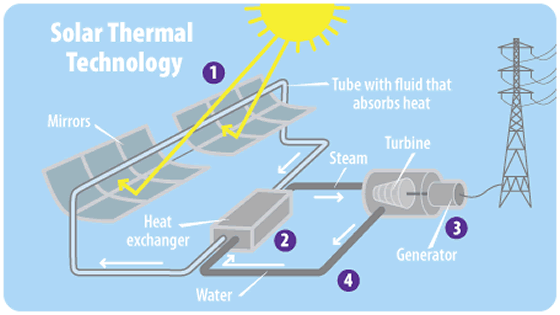Utilizing Solar Thermal Technology in Your Home
By Bryn Huntpalmer

You've probably turned on your garden hose during the summer months and noticed how warm—almost hot—the water was when it came out. Did you know that you can use the same concept to heat your home, from your living room to your pool and the hot water you use indoors? Harnessing this power can benefit not only your pocketbook, but the whole planet.
The process that heats the water in the hose is called solar thermal, or solar hydronic, heating. It is one of the most efficient, practical and cost-saving renewable energy systems available. And what's more, solar thermal energy (STE) can be a great supplement or even replacement for your current home energy sources.

Solar thermal heating is based on two principles. The first is that heated objects lost their heat to the environment. The second is that the heat loss happens more quickly when the temperature difference between the object and its environment is greater. Early solar heating systems simply involved placing a tank of water in the sun. However, there was no component that retained the heat in order to harness it. Nowadays, systems are slightly more sophisticated and can direct the heat loss from the tank toward meeting your home heating needs.
How Solar Thermal Energy Works
Solar thermal energy is slightly different from the standard solar photovoltaic (PV) system. The PV array, which is considered a passive system, consists of the solar panels—also called cells or modules—as well as the inverter and some form of battery for energy storage. Solar panels are considered passive because they function without moving parts. By contrast, a solar thermal system is considered an active system due to the flow of water.
A solar thermal system combines the efficient absorption and storage of solar energy with the heating and plumbing systems of your home. It’s fairly simple and involves only a few durable parts: heat collectors (similar to solar panels), heat transfer fluid, heat exchangers (which bring heat from the transfer fluid to the home’s water system), pumps to move the fluid, and controllers that sense when heat is available to run the system.
The first component that will be implemented when you install the system is the heat collector, which is typically a flat plate collector. This structure includes an array of solar collector tubes, typically made of copper or aluminum that lies under a layer of insulation, an absorber plate, and protective aluminum and glass. These panels are installed on the roof, flush against its surface in much the same way that you would install photovoltaic cells. The tubes contain fluid that is heated by the sun’s energy and then pumped back and forth between a heat exchanger and a storage system.
The heat transfer fluid is a non-toxic anti-freeze that not only transfers the heat to the exchanger but also prevents heat loss in colder climates. In hotter climates, the heat transfer fluid must have a high boiling point. One of the most common heat transfer fluids used in solar thermal systems is a glycol/water mixture that offers freeze protection if properly concentrated. These should be changed out every three to five years.
The fluid brings the heat to the heat exchanger, which is made of copper, steel, bronze, aluminum, or iron. There are different types of exchangers used in residential solar thermal systems, but the type that uses heat transfer fluid is called a liquid-to-liquid exchanger. The process of transferring the heat from the circulating fluid to the distribution fluid inside the tank allows for the heat to be stored in a centralized and accessible location until it's needed. The exchanger is equipped with a barrier that sits between the exchanger fluid and the domestic water supply. The water is heated through the barrier.
 Photo courtesy: EPA.gov
Photo courtesy: EPA.gov
Using Solar Thermal Heat in Your Home
Most people who decide to install a thermal energy system do so to cut the cost of domestic water heating. In fact, about 25 percent of the average household's annual energy consumption is used for water heating, which also produces about two tons of greenhouse gas emissions. However, solar thermal energy can also be used to heat your home as well. This type of solar energy is best for homes located in cooler climates that get plenty of sunshine.
In short, the process of heating domestic water involves the working fluid that carries heat to the exchanger, which then transfers the sun's solar energy to your home's water tank in the form of heat. You'll then receive hot water in your showers, sinks, and washing machine that was heated using solar thermal energy. However, in order to use solar thermal energy to heat your home, you'll have to install different equipment and also create a way for the heat to be distributed throughout the home.
In solar thermal systems that move hot air into your home, the working liquid component is air rather than anti-freeze. The collector box is not installed onto your water tank but on the outside of your home, such as on a wall or roof, and can blend in well. The collector is a black metal plate insulated with metal, perfect for absorbing heat. It has an air intake component with a fan, which allows air to pass through it and heat as it does so. It also has an output component that drives the heated air into ducts inside the home. This is a great alternative when you want to avoid paying high fuel or electricity costs to heat your home.
The Cost of a Solar Thermal Heating System
The cost of solar thermal systems varies, but as they are simpler and require fewer materials, they are more affordable than the solar modules that provide all of a home’s electricity. A typical cost for a solar thermal system is about 5,000 dollars, but there are many incentives offered to users of solar energy, and you could save at least a thousand dollars. That’s without mentioning that you will recoup much of your investment in monthly savings. Of course, your savings will depend on the amount of hot water you and your family use as well as your system’s performance. According to Energy.gov, installing a solar hot water heater should cause your bills to drop 50 to 80 percent.

Even more importantly, in addition to the systems being largely cost-effective, you’ll have the peace of mind that comes from knowing that you are taking action to reduce your family’s carbon footprint and help preserve the environment. You will be setting an example of awareness for your friends, neighbors and children, the positive effects of which will benefit us all for generations to come.
About the author

Bryn Huntpalmer is a mother of two young children living in Austin, Texas where she currently works as an editor for Modernize and nurtures her HGTV obsession. In addition to regularly contributing to home decor and design websites around the web, her writing can be found on Lifehacker, About.com and on her personal blog Her Own Wings.
Did you like the article? Subscribe here to our New Article Email Alert or RSS feeds.
Sharing is caring! Don't forget to share the love, and keep the conversation going by leaving a comment below:
Advertisement
